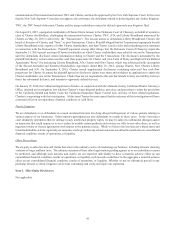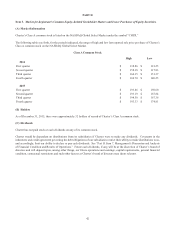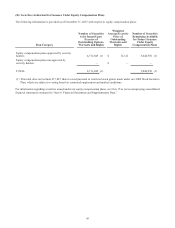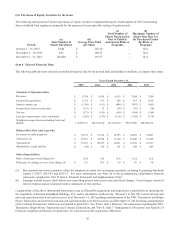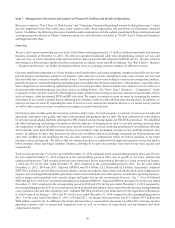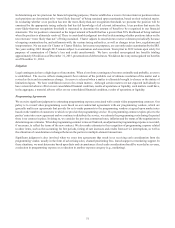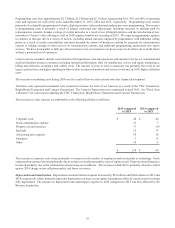Charter 2015 Annual Report Download - page 65
Download and view the complete annual report
Please find page 65 of the 2015 Charter annual report below. You can navigate through the pages in the report by either clicking on the pages listed below, or by using the keyword search tool below to find specific information within the annual report.50
Valuation, impairment and amortization of customer relationships. The net carrying value of customer relationships as of
December 31, 2015 and 2014 was approximately $856 million (representing 5% of total assets excluding restricted cash and cash
equivalents) and $1.1 billion (representing 6% of total assets excluding restricted cash and cash equivalents), respectively.
Amortization expense related to customer relationships for the years ended December 31, 2015, 2014 and 2013 was approximately
$249 million, $282 million and $284 million, respectively. No impairment of customer relationships was recorded in the years
ended December 31, 2015, 2014, or 2013. For more information and a complete discussion on our valuation methodology and
amortization method, see Note 6 to the accompanying consolidated financial statements contained in “Part II. Item 8. Financial
Statements and Supplementary Data.”
Income taxes
As of December 31, 2015, Charter had approximately $11.3 billion of federal tax net operating loss carryforwards resulting in a
gross deferred tax asset of approximately $4.0 billion. Federal tax net operating loss carryforwards expire in the years 2020
through 2035; with $560 million expiring through 2023, $5.7 billion expiring between 2024 and 2028, and $5.0 billion expiring
thereafter. These losses resulted from the operations of Charter Holdco and its subsidiaries. In addition, as of December 31, 2015,
Charter had state tax net operating loss carryforwards, resulting in a gross deferred tax asset (net of federal tax benefit) of
approximately $365 million. State tax net operating loss carryforwards generally expire in the years 2016 through 2035. Such
tax loss carryforwards can accumulate and be used to offset Charter’s future taxable income. As of December 31, 2015, $9.1
billion of federal tax loss carryforwards are unrestricted and available for Charter’s immediate use, while approximately $2.2
billion of federal tax loss carryforwards are still subject to Section 382 and other restrictions. Pursuant to these restrictions, Charter
estimates that approximately $400 million in 2016 and an additional $226 million annually over each of the next eight years of
federal tax loss carryforwards, should become unrestricted and available for Charter’s use. Charter’s state tax loss carryforwards
are subject to similar but varying restrictions.
In addition to its tax loss carryforwards, Charter also has tax basis of $4.6 billion in intangible assets and $3.4 billion in property,
plant, and equipment as of December 31, 2015. The tax basis in these assets is not subject to Section 382 limitations and therefore
is currently deductible as depreciated or amortized. For illustrative purposes, Charter expects to reflect tax-deductible amortization
and depreciation on assets owned as of December 31, 2015, of approximately $1.3 billion in 2016 and $3.2 billion between 2017
through 2020, decelerating annually. The foregoing projected deductions do not include any amortization or depreciation related
to future capital spend or potential acquisitions. In addition, the deductions assume Charter does not dispose of a material portion
of its business, make modifications to the underlying partnerships it owns, or create a new underlying partnership, all of which
may materially affect the timing or amount of its existing amortization and depreciation deductions. Any one of these factors
including pending transactions, future legislation or adjustments by the IRS upon examination could also affect the projected
deductions.
In assessing the realizability of deferred tax assets, management considers whether it is more likely than not that some portion or
all of the deferred tax assets will be realized. In our evaluation of the need for a valuation allowance, we take into account various
factors, including the expected level of future taxable income, available tax planning strategies and reversals of existing taxable
temporary differences. Due to our history of losses, we were unable to assume future taxable income in our analysis and accordingly
valuation allowances have been established against the gross deferred tax assets for book accounting purposes, except for future
taxable income that will result from the reversal of existing temporary differences for which deferred tax liabilities are recognized.
Our gross deferred tax assets have been offset with a corresponding valuation allowance of $3.2 billion at December 31, 2015.
The amount of the deferred tax assets considered realizable and, therefore, reflected in the consolidated balance sheet, would be
increased at such time that it is more-likely-than-not future taxable income will be realized during the carryforward period. We
periodically evaluate the facts and circumstances surrounding this assessment and, at the time this consideration is met, an
adjustment to reverse some portion of the existing valuation allowance would result. As of December 31, 2015, we have recorded
net deferred income tax liabilities of $1.6 billion largely attributable to the characterization of franchises for financial reporting
purposes as indefinite-lived.
In contemplation of the TWC Transaction, Charter has performed a preliminary analysis of the valuation allowance recorded on
Charter’s preexisting deferred tax assets considering the interaction of the tax positions of the acquiring and acquired entities in
the TWC Transaction. Based on this analysis, certain of the deferred tax liabilities that are anticipated to be recognized in connection
with the close of the TWC Transaction are expected to reverse and provide a source of future taxable income, resulting in a
reduction of substantially all of Charter’s preexisting valuation allowance associated with its deferred tax assets. Such release of
Charter’s valuation allowance would be recognized directly to income tax benefit on the consolidated statements of operations.
This preliminary analysis is subject to the finalization of the acquisition and the full assessment of the facts and circumstances
surrounding the possible sources of future taxable income, after the close of the TWC Transaction.



